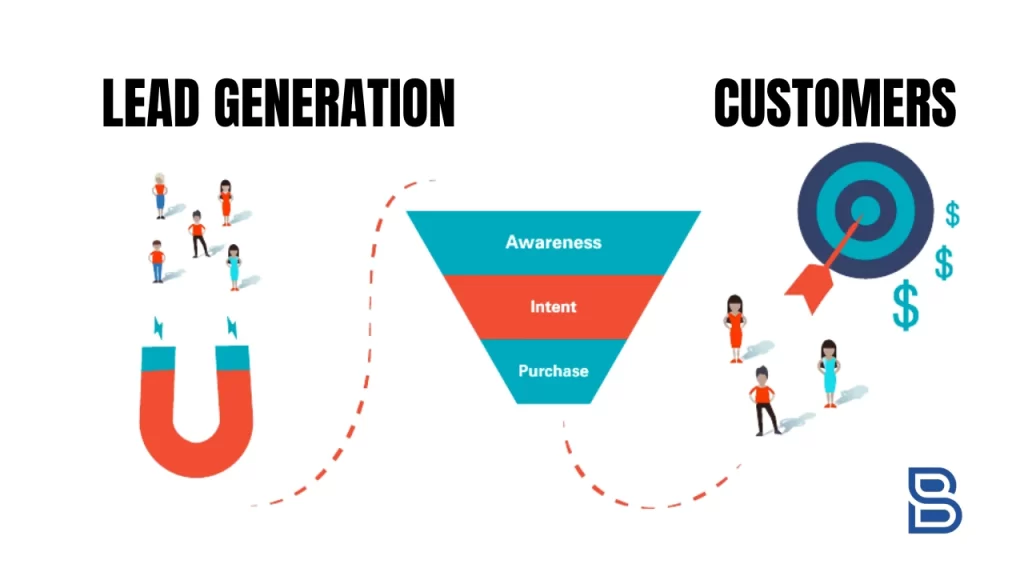
B2C Facebook Lead Ads has become a key strategy for businesses looking to expand their customer base. It not only drives brand growth and immediate sales but also helps build a loyal customer base over time through retargeting campaigns.
In this blog, we will share insights into B2C Facebook advertising, covering how to get started, creating high-converting ads, optimization techniques, and advanced strategies for maximizing lead generation. Let’s dive in!
What is B2C Facebook Advertising?
B2C Facebook advertising is a meta marketing strategy designed to promote your business-to-consumer (B2C) company across the meta platforms. The objective is to ensure your posts appear in users’ feeds, engaging them and familiarizing them with your business, ultimately drawing them to your website.
The Power of Facebook Advertising in B2C Marketing
“During a 2024 global survey, approximately 51 percent of responding business-to-consumer (B2C) marketers said Facebook was the most important social media platform.”
Facebook is still one of the most used social media. And in contrast to other social media, it’s also a successful B2C marketing platform. But why does Facebook, alongside Meta, which includes both Instagram, perform as a better marketing channel for B2C marketers? Let’s delve deeper to uncover the key reasons that make Facebook a powerhouse for B2C marketing.
1. Relevance:
With a user base surpassing 3 billion, Facebook stands as a vast and diverse marketplace. This platform empowers businesses to engage with consumers across a wide range of sectors, from everyday food delivery to luxury travel and high-value asset sales, all powered by targeted marketing. The wide-ranging interests of Facebook’s user base make it relevant for virtually any product.
2. AI Advantage:
AI has already significantly transformed the landscape of targeted advertising, enabling businesses to create content and tailor their outreach based on user behavior and preferences. With advanced AI tools on Facebook, marketers gain the capability to understand and anticipate consumer behavior, paving the way for more personalized and effective marketing strategies on the Social Media platform.
3. Short Video Era
As businesses look for new ways to engage their audiences, short-form videos are expected to provide the best return on investment (ROI) compared to other content types. Facebook’s features, like live videos and stories, give brands the chance to create captivating visual content that resonates with consumers. By using video, businesses can clearly communicate their brand message, showcase products, and build emotional connections, which helps increase engagement and shareability.
Despite the difficulties, Facebook marketing for B2C offers great chances with the right strategy and keeping up with market changes and advertising methods.

Getting Started with B2C Facebook Lead Ads
Okay, now it’s time to get started with B2C Facebook ads. Before we get into the action steps, you need to make sure of these facts that they are properly taken care of.
- Account structure
- Use Meta Ad Features
- Strategy for Bid and Budget
- The Creatives—Visuals and Texts
- Crafting High-Converting Facebook Ads
- Advanced Strategies for Maximizing Lead Generation
- Proper Ad Optimization
Account Structure:
When setting up Facebook ad campaigns, simplicity was always the key—though what “simple” meant often varied from one business to another. The golden rule remained: be honest with your objectives. In the past, some marketers tried to outsmart the system by choosing traffic objectives to score cheaper clicks, even when their actual goal was conversions or sales. But that strategy rarely paid off. Aligning your objectives with your true business goals was always the smarter move.
Ad launches, too, had their guidelines. While Facebook allowed for an unlimited number of ads, the advice was to stick to at least three ads per ad set. This provided enough variety without overwhelming your resources. And, back then, knowing exactly what ads were running and why was crucial. Some marketers made the mistake of creating 20 separate campaigns when they could’ve easily consolidated them into three. Others launched ads just for the sake of launching them, without a clear purpose.
Use Meta Ad Features:
Facebook has introduced several smart features over the past couple of years that are designed to optimize your campaigns with AI-driven tools. Here are some key features to test:
Campaign Budget Optimization (CBO): Automatically allocates your budget to the best-performing ad sets. Works best with larger budgets to help ads exit the learning phase.
Dynamic Creative Optimization (DCO): Allows you to test multiple creative variations in one ad, optimizing performance. Ideal for testing but can make building social proof harder.
Dynamic Language Optimization (DLO): Lets you run ads in multiple languages simultaneously, reaching diverse audiences without creating separate campaigns.
Value-Based Lookalikes (VBLAL): Targets users who resemble your highest-value customers, based on pixel or app data, to improve conversion rates.
Dynamic Ads: Essential for ecommerce, delivering personalized product ads to users, especially effective for retargeting.
Strategy for Bid and Budget:
To optimize your bid strategies effectively, start with auto bid, which establishes your baseline Cost Per Acquisition (CPA) and is typically the most efficient option for most advertisers. If you find your CPA results unsatisfactory, consider switching to manual bidding.
When using manual bids, set your bid to your established CPA plus 20%. This gradual approach ensures you spend your full budget while monitoring performance. Avoid adjusting your bids by more than 20% daily to prevent reverting to the learning phase.
Pro Tip: Concentrate on CPAs rather than getting sidetracked by impressions or clicks. Focus on one or two key performance indicators (KPIs) that align with your revenue goals, primarily return on ad spend.
The Creatives—Visuals and Texts:
Prioritize Video Content: Videos generally outperform static ads in B2C campaigns. While they may have a higher production cost, their longevity, engagement potential, and viral capability can significantly improve your cost per mille (CPM). Ensure you select an eye-catching thumbnail to complement your video.
Leverage Static Ads When Necessary: Static ads can still be highly effective, particularly in the ecommerce sector, where they often outperform video ads. If you’re using a product carousel, consider placing a video in the first slide to gauge its impact on engagement.
Adhere to Mobile-First Guidelines: For mobile audiences, keep video lengths between 7 to 15 seconds. This duration is optimal for capturing attention without losing viewer interest.
Optimize Ad Sizes: If resource constraints prevent you from creating assets in various sizes, the 4:5 aspect ratio works well for most non-horizontal ad placements on Facebook.
Emphasize Visuals: Focus on visually showcasing your product, as most users may not engage with the accompanying text. Use high-resolution, vibrant images that grab attention.
Keep Copy Concise: Since very few users click to “read more,” make sure your copy is brief, engaging, and easily readable at first glance.
Experiment with Creative Elements: If branding is less of a concern, try incorporating elements like emojis, exclamation points, and capitalization to see how they affect engagement.
Utilize Dynamic Creative Optimization (DCO): Use DCO to run copy tests alongside your best creative assets, allowing you to identify the most effective messaging.
Crafting High-Converting Facebook Lead Ads: 8 Steps
Creating a standout Facebook ad campaign is like weaving a captivating story that resonates with your audience. Let’s explore the art of crafting effective Facebook advertisements through a storytelling approach, complete with examples to illustrate each step.
1. Setting the Scene: Defining Campaign Goals
Imagine you’re launching a new eco-friendly product line for your brand, GreenEarth. The journey begins by defining your campaign goals. You gather your team and brainstorm: “Do we want to create awareness about our sustainable practices, generate leads for our newsletter, or drive sales for our new products?”
Example: You decide your primary goal is to raise brand awareness. This clarity will guide every decision in your campaign.
2. Identifying the Ad’s Purpose
As you dive deeper, you pinpoint the ad’s purpose. It’s not just about selling a product; it’s about telling your audience why they should care. You aim to introduce potential customers to the benefits of eco-friendly living.
Example: Your ad will highlight the impact of single-use plastics and showcase how GreenEarth’s products offer a sustainable alternative.
3. Choosing the Right Campaign Objective
Next, you navigate Facebook’s Ads Manager, carefully selecting the right objective. You remember your goal of raising brand awareness. So, you choose the “Brand Awareness” objective to ensure your ads reach as many relevant users as possible.
Example: By selecting this objective, your ads will be optimized to reach users who are likely to remember your brand.
4. Determining Success Metrics
With your campaign structured, it’s time to set success metrics. You decide that measuring impressions, reach, and engagement will indicate how well your story is being received.
Example: Your team agrees to track the number of people who click on your ad and visit your website for more information on sustainable products.
5. Understanding Your Target Audience
Now comes the critical step of understanding your audience. You take a step back and conduct thorough research, diving into demographics and psychographics. You find that your ideal customer is environmentally conscious, aged 25-40, and active on social media.
Example: Using Facebook’s Audience Insights, you discover that many of your potential customers enjoy outdoor activities and follow sustainability-related pages.
6. Creating Audience Segments for Personalized Ads
Armed with this knowledge, you segment your audience into groups based on interests, behaviors, and demographics. This allows you to tailor your ads specifically for each segment.
Example: You create one ad targeting young families interested in eco-friendly products and another for millennials who are passionate about sustainability.
7. Crafting Compelling Ad Copy and Visuals
With your audience segments defined, you move on to crafting compelling ad copy and visuals. You write engaging headlines that capture attention and pair them with vibrant images of your products in natural settings.
Example: Your ad copy reads, “Join the Movement: Say Goodbye to Single-Use Plastics!” accompanied by an eye-catching image of your reusable bags at a beach cleanup.
8. The Lightbulb Moment: Discovering the Facebook Ad Library
The Facebook Ad Library is a powerful tool that provides a wealth of inspiration for advertisers. It allows users to see every ad a Facebook page is running, including key details like duration, engagement metrics, and creative elements.
Example: For instance, if you’re promoting a fitness app, look for other fitness apps. You might discover a company with a video ad campaign featuring user success stories, each with unique messages and images.
Advanced Strategies for Maximizing Lead Generation
While selling products through Facebook ads is effective, collecting leads is also an important part of B2C Facebook advertising. Here are six advanced strategies for maximizing lead generation.
Run Facebook Lead Ad Campaigns
Meta Lead ads make it easy for people interested in your products or services to get updates by using instant forms that automatically collect their contact details, especially on mobile. This makes signing up quick and convenient for users, while also helping you gather interested leads for your business.
Optimize Landing Pages
Improving your landing pages is key to increasing visitors and getting more people to take action. Begin by clearly showing what you offer and how it will benefit them. Use social proof like customer logos or reviews to make users trust you more. Be open about how you’ll handle their information. Make sure your page works well on mobile and has a nice thank you message after they submit.
Optimize Lead Forms
Lead generation forms are key in gathering potential customers’ details and are usually the last step in a successful campaign. To make them work best, it’s crucial to choose the right amount and quality of information to ask for. Simple forms are faster and easier for users, which can increase the chances of getting them to fill them out. By keeping the form simple, you improve the user experience while still getting the important information you need.
Optimize Call to Action
CTA buttons are crucial for getting more visitors to take action on your website. Make sure the text is brief and clear, highlighting the benefits that motivate people to act. Use action-focused language, match your CTAs with the content on your pages, and play with colors to make them stand out. To increase engagement, make users feel they need to act quickly, try various texts and designs, and ensure your CTAs work well on all devices. Also, make sure your CTA buttons are easy to see and lead users to the desired action.
Add Live Chat
Using live chat on your website can greatly improve sales and customer support. It offers quick, easy communication for visitors, making it easier for them to interact with your business. Many companies have seen a boost in sales after adding live chat, with an average increase of 20%. This feature helps you quickly answer customer questions and make sales before competitors can.
Show Testimonials
Including customer reviews on your landing pages can boost sales by making new visitors trust your products more. Ask your previous customers to write reviews after they buy. Use reviews from Google, Facebook, or other places. Contrary to what many think, you should only post good reviews and address any negative ones by fixing customer issues or product problems.
Boost Sales with B2C Facebook Advertising
Facebook’s large audience and features like dynamic ads and retargeting make it a good choice for B2C marketers to boost brand awareness, get leads, and boost sales. Many B2C brands use Facebook well for launching products, running promotions, and building customer relationships.
Start Your Facebook Ads Today (CTA)

